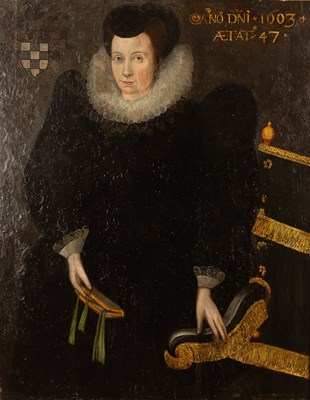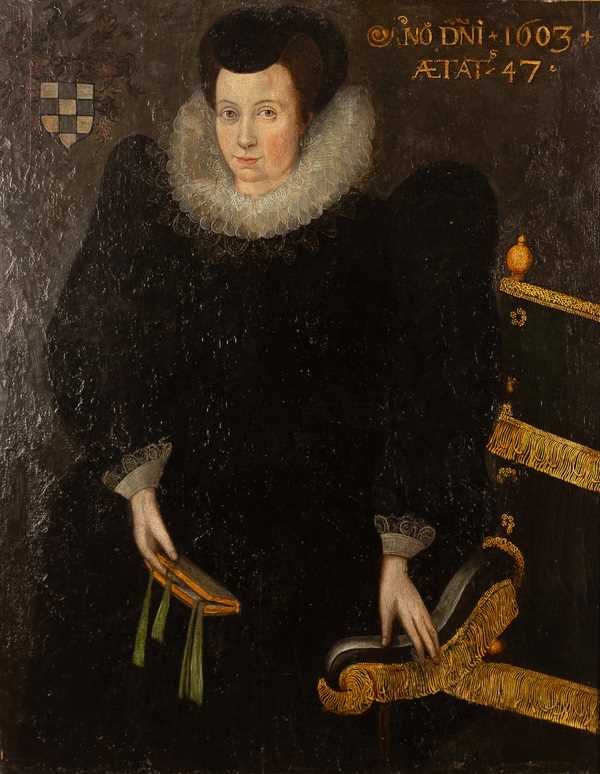27th Apr, 2021 10:00
Modern Art & Design, The Laskett
78
English School, early 17th Century/Portrait of Anne Shirley, Widow of John Brooke/three-quarter length, wearing a black dress and holding a book in one hand, the other resting on a chair/inscribed 'ANO DNI 1603 AETATs 47' and with a coat-of-arms upper left/oil on panel, 111cm x 88cm/Note: Anne Shirley (1554-1608) was the daughter of Francis Shirley of Staunton Harold, Leicestershire (1515-1571) and Dorothy Gifford and wife of John Brooke (died 1598) of Madeley Court, Shropshire. John's father, Sir Robert Brooke (died 1558) was a major jurist, MP for the City of London in five Parliaments and Speaker in 1554, the same year in which he was made Chief Justice of the Common Pleas. John was his son by his father's first wife, Anne Waring whom he married in 1537. John inherited the Madeley Court estate which had been purchased by his father in 1544 and which was to be the family seat for two centuries, although he did not obtain it until after the death of his father's second wife, Dorothy Gatacre, about 1572. He was responsible for the handsome gate house which still survives; the house is now a hotel. The Brookes were conservative in religion and latterly recusant. By the middle of the 18th Century the family had slipped from prominence as the estate was divided and sub-divided, this portrait presumably descending by way of one of these fragmentations. It depicts the sitter as a widow in black clasping a prayer book with one hand, the other resting on an opulent chair upholstered with gilt nails and fringing. The latter are carried out over gold leaf, a technique abandoned by the new wave of artists in the 1590s. The perspective of the chair is typically Elizabethan and a parallel treatment occurs in George Gower's famous Armada Portrait of Queen Elizabeth I. The extraordinary attenuated rendering of the hands could form the basis for identifying other works by what must have been a provincial artist/Provenance: The portrait turned up in a local saleroom in Pontrilas, minus its identity which, thanks to the coat of arms top left, was established by a member of the College of Arms. Purchased at a sale at Nigel Ward & Co., Pontrilas, Hereford, 2nd July, 2011, lot 310
Sold for £6,500
English School, early 17th Century/Portrait of Anne Shirley, Widow of John Brooke/three-quarter length, wearing a black dress and holding a book in one hand, the other resting on a chair/inscribed 'ANO DNI 1603 AETATs 47' and with a coat-of-arms upper left/oil on panel, 111cm x 88cm/Note: Anne Shirley (1554-1608) was the daughter of Francis Shirley of Staunton Harold, Leicestershire (1515-1571) and Dorothy Gifford and wife of John Brooke (died 1598) of Madeley Court, Shropshire. John's father, Sir Robert Brooke (died 1558) was a major jurist, MP for the City of London in five Parliaments and Speaker in 1554, the same year in which he was made Chief Justice of the Common Pleas. John was his son by his father's first wife, Anne Waring whom he married in 1537. John inherited the Madeley Court estate which had been purchased by his father in 1544 and which was to be the family seat for two centuries, although he did not obtain it until after the death of his father's second wife, Dorothy Gatacre, about 1572. He was responsible for the handsome gate house which still survives; the house is now a hotel. The Brookes were conservative in religion and latterly recusant. By the middle of the 18th Century the family had slipped from prominence as the estate was divided and sub-divided, this portrait presumably descending by way of one of these fragmentations. It depicts the sitter as a widow in black clasping a prayer book with one hand, the other resting on an opulent chair upholstered with gilt nails and fringing. The latter are carried out over gold leaf, a technique abandoned by the new wave of artists in the 1590s. The perspective of the chair is typically Elizabethan and a parallel treatment occurs in George Gower's famous Armada Portrait of Queen Elizabeth I. The extraordinary attenuated rendering of the hands could form the basis for identifying other works by what must have been a provincial artist/Provenance: The portrait turned up in a local saleroom in Pontrilas, minus its identity which, thanks to the coat of arms top left, was established by a member of the College of Arms. Purchased at a sale at Nigel Ward & Co., Pontrilas, Hereford, 2nd July, 2011, lot 310
Auction: Modern Art & Design, The Laskett, 27th Apr, 2021


